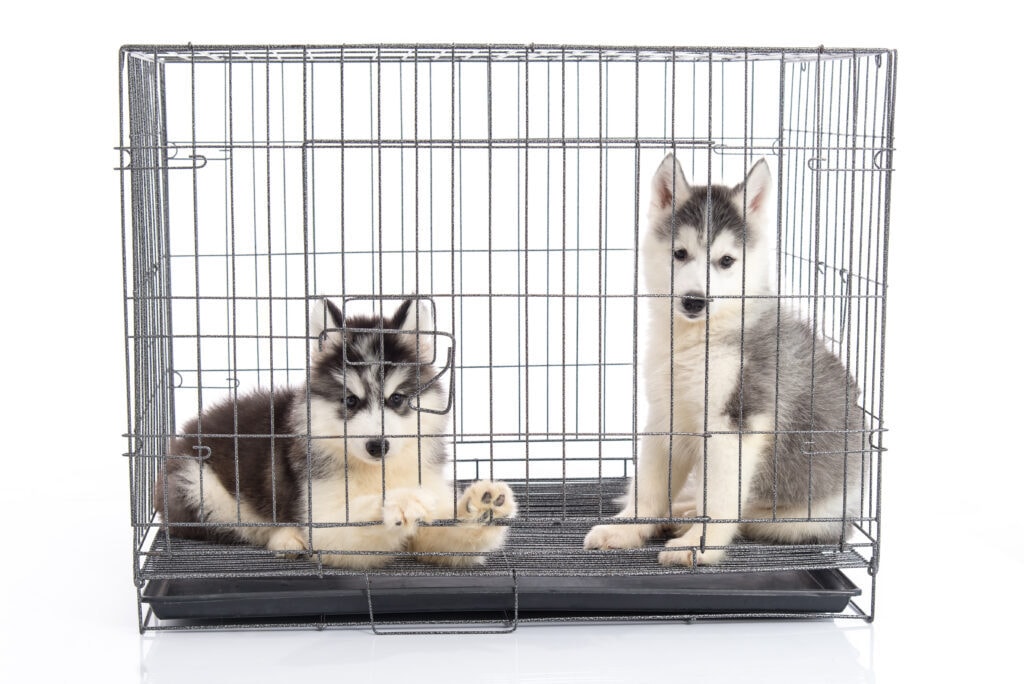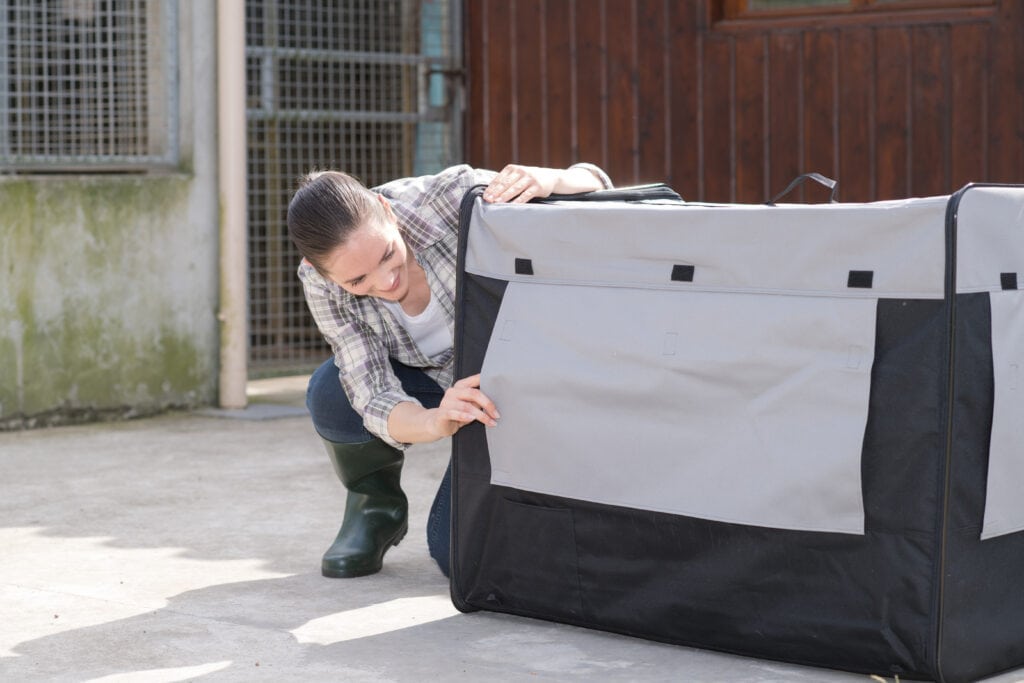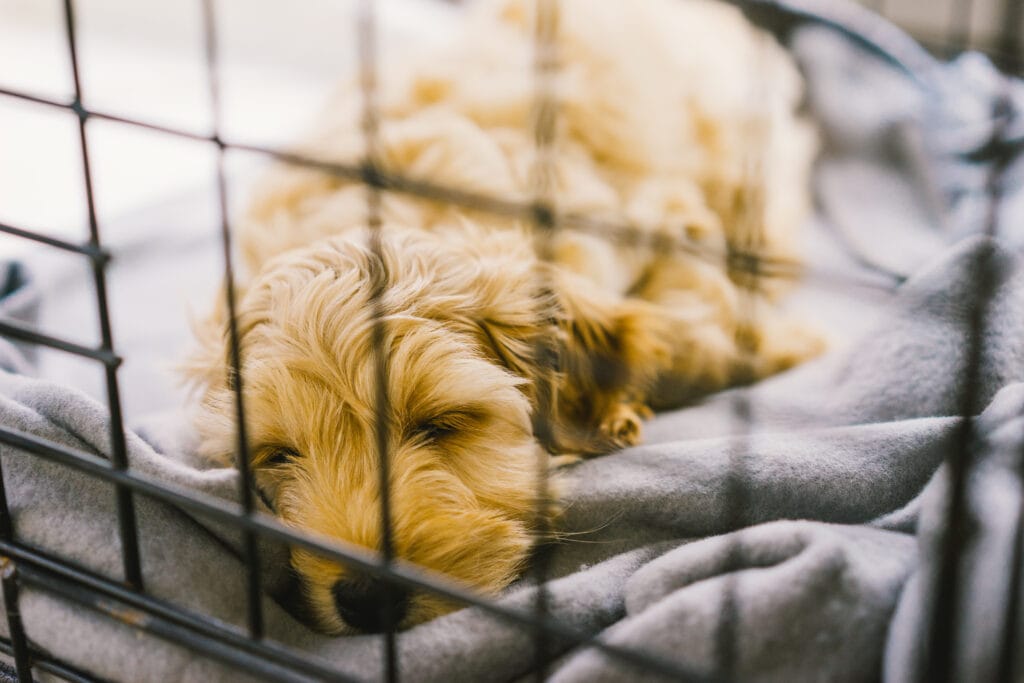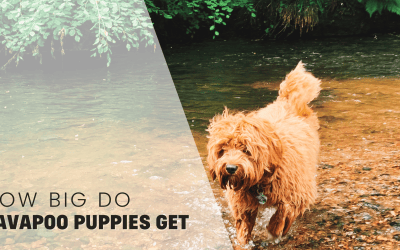Crate training is a very effective way to implement structure and routine and to assist with toilet training in your young puppy’s life.
I want to give you some rules to follow for the process of crate training your puppy, because crate training can be hard. Mainly because of when crate training tends to happen in a puppy’s life is some of your most emotionally difficult moments! It comes (normally) when puppy comes home at week 8, at the start of a fear phase, and suddenly bereft of all they’ve known… confusing, huh? Then you’re tired, exhausted even, emotions are high and the puppy blues looms…
It’s easy to get tetchy and emotional, and to take it out on puppy. I implore you, don’t do this.
So, here it is!
Rebarkable’s Golden Rules Of Crate Training.
1 – Crates Are A Safe Space.
The prime directive of the Golden Rules . The crate must be a safe zone. The environment not only needs to be not only welcoming, but calm and safe. This needs to become your dogs place of rest, relaxation and a zone of zen. A Zen Den even!
No matter what happens in there, it’s fine. Poop and pee can be cleaned up, negative associations? Are much harder to resolve. So peace and harmony please!

2 – No Sharing Crates.
Whether with a human child, or another dog (unless they choose to and the doors are open). Crates shouldn’t be a space shared. They’re a space for just your dog to relax and take their own sweet time about decompressing from the events of the day. Think of it like your pup’s self care.
Also, with regards to children? This is a massive no-no. Dogs and puppies can find children quite stressful, having a space where they know they will be entirely undisturbed allows them to begin to regulate their own sleep and retreat away from a situation that may escalate. Allow them that escape.
3 – Do Make A Positive Association
One of the easiest ways of doing this? Is to leave treats in there. Hide them in amongst the bed and blankets, make it a game! but if your dog keeps a strong association with positive experiences with their crate – then it’s a great way to make it as easy as possible. Also consider rule 11 when doing this.
If you’re giving any treats through the day for mental stimulation or teething, like a kong or a bully stick, they’re great to ask puppy to head to bed (you can use a bed cue to start making the association with the space and lay the foundation for the cue!) and lure them in with their wonderful treat. You may have to hold it for a minute in there until they settle, but it’s another great way to make a crate a positive experience.
4 – Do Put In A Comfy Bed
Beds are really important, not just to make the crate inviting, but to make sure that whilst they are in there, it’s a place they want to remain. A good bed (as good as you can afford!) will last a long time if you take care of it, and it will also make their crate at least as appealing as your sofa, or your bed – which is always a plus!
Quick tip!: Make sure the bed has a zipper so you can wash the external cover!
Blankets allow your puppy to make their bed and lay in it – quite literally!
Ali Smith
5 – Consider A Blanket
Now, Indie, My German Shepherd cross would probably die (dramatically) if there were a blanket in his crate – but he’s a dog who thrives in colder climates – and this would be too much.
Our hounds, on the other hand? The hounds love their blankets, and in fact, we’ve had exploding beds before (Lucy keeps trying to tell me it was a squirrel that got into the house…) and the blankets mean they have somewhere to focus their desires to dig and nest – and it’s saved the beds too – must be a special squirrel deterring blanket…
Point being! Blankets make crates more comfortable, and a better experience for your pup. Blankets allow your puppy to make their bed and lay in it – quite literally! Which will likely be the only space in your house where this is perfectly acceptable.
A simple fleece blanket works really well, they wash well too so you can avoid that wonderful dog stank!
6 – Cover The Crate
Crate covers are wonderful inventions, not only do they make a black wire crate look more appealing in a family space – they also allow a visual barrier which can be really helpful for breeds who like to watch things by eye, or are stimulated by sight – like sighthounds, or herding breeds. It can also dampen noises slightly (great for loud noises or busy households!), and help them keep cosy and warm. It also may help to mitigate any early morning sunlight depending on where you put the crate.
Please note! This should only be done with an appropriate sized crate cover, as there is a risk of strangulation or ingestion if puppy pulls a normal blanket through the bars. I’ve known it to happen. Find one (or make one!) that fits.

7 – Only Recall Your Puppy From Their Crate.
Our next golden rule is based in consent. If they want to continue to sleep – that is ok! Whatever you do, regardless of how friendly your dog is, you don’t go in the crate, a hand may be acceptable if there are treats involved, but generally try and avoid it if you can. This comes down to the equivalent of knocking on a door, there has to be respect of their space and their desire to do what you want them to.
8 – Balance Your Puppy’s Time In Their Crate
Puppies are rubbish at knowing their own limits. Often times they’ll get overtired or over-aroused if they don’t get the sleep they need. You have to use the crate sparingly. Overnight is fine because it’s sleepy time!
However, during the day, I would encourage you to leave them in there for their sleeping hours only, unless you’re out of the house (and puppy is not yet responsible and tested to be ‘loose’), whilst toilet training (and you can’t watch them for a short amount of time), or whilst teaching them to be alone (for short periods of time to begin).
A good guide is as follows…
| Age | Time In Crate (Out Of Crate Hours: In Crate Hours) |
| 2 months | 1:2 |
| 3 months | 1:2 |
| 4 months | 1:1 |
| 5 months | 1:1 |
| 6 months | 3:2 |
| 7 months and over | 2:1 |
9 – Work Up To As Much Freedom As Possible
Your golden rules come up to number nine with my request to make sure that you grant as much freedom as your home situation allows, whilst remembering to set them up for success at every step along the way.
One of the big reasons you probably got a puppy was to have them serve as a watchdog – now not all watchdogs have to be guard dogs, but a chihuahua or a yorkshire terrier are just as effective as a belgian malinois or a cane corso at alerting you to an intruder. They’re better able to do this if they have their freedom around your home (or areas of your home).
But, also, they may like to wander, to balance out their temperatures, or just stretch their legs a little at times. Allowing them to do this, and keep their crate (say with the doors open!) is a great way to allow your (now responsible) puppy to self regulate.
What Crating Is Never…
It’s also good to know exactly what crate training is never meant to be as part of the Golden Rules Of Crate Training – these will help guide you to remember what you should be doing when things might threaten to slip just a little because raising a puppy is tough, and we are human, and have emotions sometimes we get angry.
Just try to remember your line. Feel the emotion, just don’t take it out on pup! That’s fine. We need to prioritise positive bonding to prevent any fear associated with you.
10 – Crating Is Never A Punishment
There is a fine line between “Bad dog! Get in your bed!” whilst your puppy is being dragged and pushed into a crate and a time out for them when they’re being over stimulated. Avoid shouting (which is always a great tip) and try and get them to go in voluntarily, it should decrease the amount of issues you will have when puppy is in there.
11 – Crating Is Never An Excuse To Avoid Training
Just because puppy loves their crate, does not mean that you can avoid training them to be a considerate member of your family, okay?
It can be tempting, but don’t do it to yourself or your puppy.
We all have days where we’re exhausted, flat out tired from work, education, or even just a day of socialising when you might be tempted to just leave them be, quietly in their crate. But. This is a false economy.
In the long term, your puppy will suffer and so will you. You won’t have a dog who is a family member. You’ll have a dog that is at your convenience, and both of you will miss out on that fantastic kinship between human and dog. Which kind of defeats the object, huh?

Follow These Golden Rules To Ensure Crate Training Success!
And that’s it! The 11 golden rules of crate training. If you intend on crate training, you need to know these before you and puppy begin. They’ll really help you to balance your and puppy’s co-existence and let’s face it! Being comfortable in a crate is a necessary skill for modern dogs – whether you use it as their bed or otherwise.
So yes! Best of luck, and if you need any more help, why not look to our pupdates? They’ll help you fathom everything from how long your puppy needs to sleep, to what you can expect as they hit adolescence!
Oh! And let us know if these golden rules help and share them with your friends.
Sign Up For Pupdates!
Grab your weekly emails to help you learn how to best care for your quickly developing puppy!
It covers everything from training and vaccinations, to socialisation to setting up your puppy support network!






0 Comments